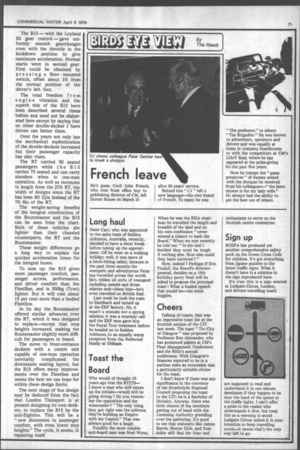Is B15 the best?
Page 72

Page 73

If you've noticed an error in this article please click here to report it so we can fix it.
continued from page 69 Access to the cab of the 1959 Routemaster was far simpler than the RT and the flat floor inside made it appear • far more spacious. As with the RT and the Daimler Fleetline I thought a useful safety feature was the domed metal head of the accelerator pedal which gave it a completely different "feel " from the flat surface of the brake pedal. In the B15 t h e brake and accelerator pedals both had a similar shape and felt the same, although the accelerator was bare metal while the brake was rubber• covered.
The ride in the cab of the Routemaster was much better than either the RT or Fleetline, although the steering wheel still shook excessively both with engine vibrations and with road bumps.
The Routemaster can be driven as either a semior fully-automatic. With the gear selector in "top gear" position the bus pulls away in second gear and changes up automatically to third and top, although all gears can be held manually by selecting the appropriate slot on the columnmounted gear selector.
Unlike the RT, steering is power assisted which, combined with the power hydraulic brakes, made the RM an effortless vehicle to drive.
The introduction of rearengined bus designs in the late 50s separated the driver from the power unit and thus removed him from the noise and vibration of the engine. The ease of access to the " cab " and its increased spaciousnes were added advantages to him.
After the smooth ride of the Routemaster the Fleetline front suspension seemed very hard and the bus had a definite pitching motion on rough sections of track. This could perhaps be put down to the fact that the particular bus was brand new and had not yet entered service. The B15 — with the Leyland B2 gear control — gave uniformly smooth gearchanges even with the throttle in the kickdown position to give maximum acceleration. Normal starts were in second gear. First could be obtained by pressing a floor-mounted switch, offset about 1 ft from the normal position of the driver's left foot.
The total freedom f rom engine vibration and the superb ride of the B15 have been described several times before and need not be elaborated here except by saying that no other double-decker I have driven can better them.
Over the years not only has the mechanical sophistication of the double-deckers increased but their passenger capacity has also risen.
The RT carried 56 seated passengers while the B15 carries 75 seated and can carry standees when in one-man operation. As well as increases in length from the 27ft RT, the width of designs since the RT has been 8ft 21-in instead of the 7ft 6in of the RT.
The weight-saving benefits of the integral construction of the Routemaster and the B15 can be seen from the chart. Both of these vehicles are lighter than their chassied counterparts, the RT and the Routemaster.
These weight differences go a long way to explain the quicker acceleration times for the integral buses.
To sum up: the B15 gives more passenger comfort, passenger access, performance, and driver comfort than the Fleetline, and is 300kg (7cwt) lighter. But it will cost about 15 per cent more than a bodied Fleetline.
In its day the Routemaster offered similar advances over the RT, which it was designed to replace—except that step heights increased, making the Routemaster slightly more difficult for passengers to board.
The move to front-entrance deckers with a centre exit capable of one-man operation inevitably complicated the downstairs seating layout, but the B15 offers many improvements over the Fleetline and seems the best we can hope for within these design limits.
The next stage of bus design may be deduced from the fact that London Transport is at present designing its own deckers, to replace the B15 by the mid-Eighties. This will be a "new dimension in passenger comfort, with even lower step heights." The cycle, it seems, is repeating itself.




























































































































